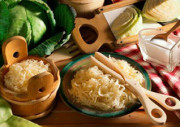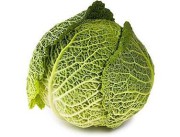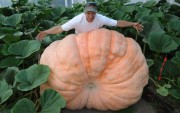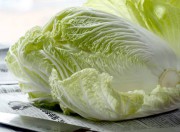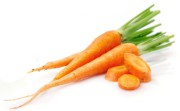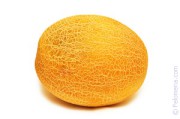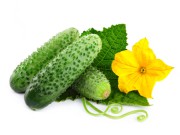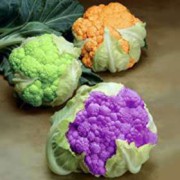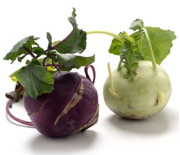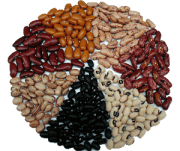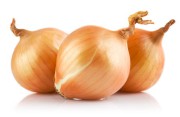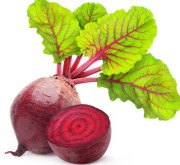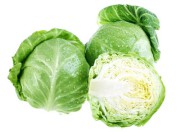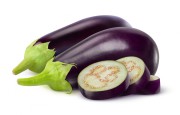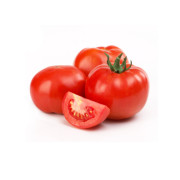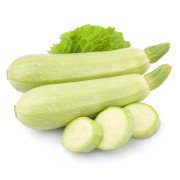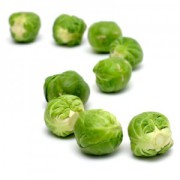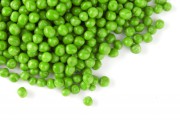Vegetables
Sauerkraut - benefits and harm to the body or what is sauerkraut useful for.
Fresh white cabbage contains a lot of vitamins and microelements. Do they remain in fermented water? And how is sauerkraut beneficial for the body?
Savoy cabbage beneficial properties. What savoy cabbage looks like and what is its harm.
In appearance, Savoy cabbage is very similar to our white cabbage, but it has a looser head with ribbed leaves that are easily separated from the stalk. This property is very useful when preparing cabbage rolls and salads. Have you ever tried to separate the leaves from cabbage? Surely half of the leaves will break, and the veins are thick, they either have to be cut off or beaten off. Therefore, Savoy cabbage is ideal in this regard, its leaves separate very well and the veins are completely invisible. It is also good for stewing and frying. The only thing you shouldn’t do is salt it for the winter, since the leaves of this vegetable are very tender.
Pumpkin - benefits and harm to the body. Description, properties, vitamins and calorie content of pumpkin.
Pumpkin is a herbaceous plant belonging to the Cucurbitaceae family. The first historical mention of pumpkin cultivation dates back to 5 thousand years BC. The fruit of the plant is pumpkin, which in people and literature is more simply called pumpkin. There are varieties of the plant, the fruits of which weigh only a few hundred grams; the largest documented pumpkin was included in the Guinness Book of Records, its weight exceeded 820 kg.The record was set by a US farmer in 2010.
Parsnip root: beneficial properties and harms of the parsnip plant, what it looks like and how to prepare it for the winter.
How much do you know about parsnips? No, we are not talking about the famous poet Boris Pasternak, but about a root vegetable whose history goes back to the Inca culture of Peru, or it is correct to call it aracacha - that is how the Quechua Indians designated this plant.
Chinese cabbage - benefits and harm for the body. Properties, calorie content and what vitamins are in Chinese cabbage.
Chinese cabbage, also known as cabbage, is a plant of the Brassica family. China is considered the birthplace of this type of cabbage. Thanks to its properties, combining the benefits of green leafy salads and the taste of white cabbage, it has become popular all over the world.
The benefits of carrots and harm to the human body: properties, calorie content and what vitamins are in carrots.
Carrots are a very popular biennial plant among many gardeners. Carrots are unpretentious and do not require much care and therefore grow in almost any climate zone, except the far north.
Melon plant: properties, description, calorie content, what are the benefits of melon and harm to health. Is it a berry, fruit or vegetable?
Melon is a melon crop and belongs to the family of pumpkin plants and the cucumber genus. The melon fruit is a false berry, having both a spherical and an oblong elongated shape, yellow, brown and even white. A ripe melon can weigh about 200 g, and can reach 20 kg.
Fresh cucumbers - benefits and harm to the body: properties, vitamins and calorie content of cucumbers.
The common cucumber is the name given to an annual herbaceous plant of the Cucurbitaceae family. This amazing fruit was known more than 6 thousand years ago. Their homeland is considered to be the tropical and subtropical regions of India and China.
Cauliflower - beneficial properties, benefits and harm to the body. Why cauliflower, what it looks like and how it is useful.
Cauliflower is a vegetable plant belonging to the cabbage family, type – cabbage. Historians consider the Mediterranean to be the homeland of cauliflower; the first official mention of the species refers to the state of Syria. It was from there that cabbage came to Europe, and a little later spread throughout the world.
Kohlrabi cabbage: properties, benefits and harms, vitamins, composition. What kohlrabi cabbage looks like - description and photo.
Kohlrabi is native to Northern Europe. Here, according to chroniclers, cabbage first appeared in 1554, and 100 years later it spread throughout Europe, including the Mediterranean. Translated from German as “cabbage turnip”.
Beans: benefits and harms for the body. Properties, contraindications, chemical composition, description and use of beans in cooking.
Beans can rightfully be called the most ancient product, dating back seven thousand years of its unique history. In ancient times, beans were a favorite food item among the ancient Egyptians and Ancient China. In European countries, they learned about beans after the discovery of the American continent.
Onions: benefits and harm for humans, calorie content, what vitamins are in onions.
Onion is a biennial or perennial plant belonging to the onion subfamily. The first mention of onions dates back to the 20th century BC; healers for many centuries have used this plant as a panacea for all possible diseases. With the development of science, scientists were able to substantiate this fact quite scientifically: thanks to the phytoncides contained in onions in huge quantities, many “bad” bacteria actually die from exposure to onions.
Sweet bell pepper - benefits and harm. What are the properties, vitamins and calorie content of pepper.
Sweet bell pepper is an annual plant belonging to the nightshade family. Peppers are called sweet peppers due to their specific, sweetish taste and juicy flesh, which can be green, red, yellow, orange or brown. The color depends on the plant variety and the degree of ripening of the particular fruit.
Red beets - harm and benefits of beets for the body: properties, calorie content, vitamins.
Humanity has used beets for food since ancient times. People have long noticed that in addition to nutritional value, beets have a variety of beneficial and medicinal properties. And this is no coincidence. After all, the beet root contains vitamins, minerals and biologically active substances. Since ancient times, beets have been used to improve digestive processes and metabolism, and also as a general tonic.
White cabbage: benefits and harm to the body, description, composition and characteristics. What vitamins and calories are in white cabbage.
White cabbage is a garden crop widespread in all countries of the world.It can be grown almost anywhere. 100 g of cabbage contains only 27 kcal. It has many vitamins and minerals.
Eggplants: benefits and harms, contraindications for health. What are their properties, description, vitamins and calorie content of eggplants.
Eggplants belong to the herbaceous plants of the nightshade genus. This tropical vegetable crop is perennial in its homeland, but in temperate climates, eggplant is grown as an annual plant. Eastern India is considered the birthplace of eggplant, from where this vegetable came to China and the countries of Central Asia, and from there, thanks to the Arabs, it spread to Mediterranean and African countries.
Health benefits and harms of tomatoes. Properties, description, characteristics and calorie content of tomatoes. What vitamins are in tomatoes?
The homeland of the tomato is South America; the first mention of the red fruit, familiar to every resident of Russia since childhood, dates back to the times of the Aztecs. In Europe, they became acquainted with tomatoes in the 16th century; the vegetable was brought to Russia only in the 18th century.
Zucchini: benefits and harm to health. Calorie content, properties, vitamins and description of the zucchini plant.
Zucchini is a vegetable belonging to the family of pumpkin plants, a subspecies of the common pumpkin. The zucchini fruit has an oblong shape; young zucchini has a bright green color; as it ripens, it may change to pale yellow or white.
Brussels sprouts health benefits and harms. Properties, description, vitamins and chemical composition of Brussels sprouts.
Brussels sprouts belong to the cabbage family, a subspecies of the plant is cabbage.Brussels cabbage is a biennial; small heads are formed in the first year and seeds in the second.
Green peas are a leguminous crop. What are the benefits of peas and harm to the body.
Green peas belong to the legume family. At the same time, the beans are green pods, and the seeds are peas that ripen inside. The plant may differ in both the shape of the pod and the shape of the seeds, as well as in taste characteristics; these indicators depend on the pea variety.

